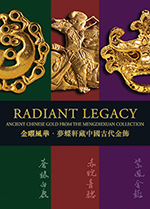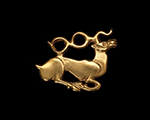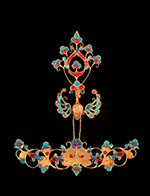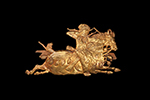 Gold has been a symbol of wealth and power since time immemorial, and it has a special commemorative meaning attached to 50th anniversaries. To celebrate CUHK's Golden Jubilee, the Art Museum and the Department of Fine Arts are staging a joint exhibition to showcase 300 Eurasian and Chinese gold artefacts selected from the Mengdiexuan Collection, Hong Kong. The exhibits span a period of over 3,000 years, dating from ca. 1500 BCE to 1700 CE. This is the first comprehensive, systematic presentation of gold in ancient China held in a Hong Kong museum. Gold has been a symbol of wealth and power since time immemorial, and it has a special commemorative meaning attached to 50th anniversaries. To celebrate CUHK's Golden Jubilee, the Art Museum and the Department of Fine Arts are staging a joint exhibition to showcase 300 Eurasian and Chinese gold artefacts selected from the Mengdiexuan Collection, Hong Kong. The exhibits span a period of over 3,000 years, dating from ca. 1500 BCE to 1700 CE. This is the first comprehensive, systematic presentation of gold in ancient China held in a Hong Kong museum.
When gold was introduced into China ca. 1500 BCE by non-Chinese people living to its north and west, it was an intruder in a society that valued jade and bronze as material indicators of rank and prestige. Gold's arrival provided not just a new visual appeal but also impetus for artistic, technical and cultural dialogue between China and its neighbours. With the help of archaeological discoveries in China, Central Asia and Russia, this exhibition will explore the meaning of gold in different cultural contexts and the dynamic interactions among them over 3,000 years. This exhibition and the publication of its catalogue are led and coordinated by Professor Jenny F. So, Professor of Fine Arts, and guest-curator of this exhibition. The exhibition will be divided into three sections: "Gold in the Eurasian Steppes", "Gold in the High Plateau" and "Gold in China", with details as follows: - Gold in the Eurasian Steppes – begins with the arrival of gold personal ornaments along China's northern borders (ca. 1500 BCE), gold's incursion into China and its effect on local production techniques, types and decorations into the 6th century CE.
- Gold in the High Plateau – the highlight of this exhibition, rediscovers the previously unknown gold of the Tubo (or ancient Tibetan) culture, one of Tang-dynasty China's main rivals in the 7th and 9th centuries, thus opening a new chapter in the history of gold in China.
- Gold in China – reveals the ways in which gold was integrated and transformed into familiar Chinese artefacts from the 1st to 17th centuries.
The exhibits are displayed accordingly and are fully illustrated by a 3-volume bilingual catalogue.
Eight selected pieces are highlighted below: 1 |  | Cast gold recumbent stag ornament
6th to 5th century BCE
L 8 cm, W 6.5 cm, Wt 61.35 g This ornament is made of cast gold. The stag lies with its legs folded underneath its body. Its antler takes the form of rings that reach all the way to its tail. Stags with similarly coiled antlers were a popular motif on ornamental plaques from the sixth to fourth century BCE throughout the Eurasian steppes as far as Inner Mongolia and north China. | 2 |  | Cast gold plaque with granulation and animal face inlaid with red gemstone or glass
3rd to 6th century
L 3.3 cm, W 3.2 cm, Wt 26.35 g (with inlays) The plaque is cast as the face of a fabulous animal, its eyes and forehead inlaid with red gemstones or glass. Gold granulation fills the ground of the face and adds linear accents to the horns and mouth. Such ornaments for the headdress had been used as official insignia since the Han dynasty and subsequently also had a use in Buddhism and Daoism. | 3 |  | Hammered gold plaque with winged horses
7th to 9th century
L 21.9 cm, W 7.8 cm, Wt 68.4 g (with wood back) This gold plaque is decorated with a pair of horses in full gallop. Each horse has a single horn and three layers to each wing, its mane and tail flying up. The plaque is attached with gold nails to a thin wooden support. Traces of black lacquer are sandwiched between the gold and the wood back, suggesting that at one time, the plaque formed the decoration on a lacquered wooden object. | 4 |  | Cast gold plaques with bird motifs
7th to 9th century
L 4.3 cm, W 4.1 cm, Wt 9.5, 10 g This pair of plaques displays extraordinary craftsmanship. An outer border of large pearl-like granules encloses an inner border of smaller granules. The standing bird on each plaque has a large round eye, large claws and layered wings. Delicate hatched lines are chased on the chest and wings to suggest a thick layering of feathers. | 5 |  | Hammered gold headdress with gem, glass and shell inlays
8th century
L 8.7 cm, W 5 cm, Wt 3.4 g (with inlays) The headdress is a complex configuration of a phoenix and three plaques. The phoenix's body is formed from hammered gold sheet, whereas its wings and tail are made separately of pierced gold sheet decorated with gold wire, turquoise, carnelian and blue and blue-green glass inlays, as well as granulation. The tail is removable. The legs are made of gold wire, with one end inserted into loops at the back of a large gold plaque. A comparable headdress was recovered almost intact from the Tang dynasty tomb of Princess Li Chui, who died in 736. As demonstrated by the princess's headdress, this headdress and similar gold head ornaments in the collection could have been worn together in an elaborate configuration. | 6 |  | Hammered gold plaque with a horse and mounted archer
7th to 9th century
L 31.1 cm, W 17.4 cm, Wt 173.9 g (with wood back) On this plaque, a horse and mounted archer are depicted in a spirited gallop. The archer's head is wrapped in a scarf, his braids flying out behind his shoulder. He has fierce eyes, big nostrils and a full beard. His bow is drawn and ready to shoot, his foot pressed down in the stirrup to steady himself. The archer wears a long, tight-fitting robe with large, triangular lapels, and both lapels and cuffs have a decorative trim. A long quiver hangs from his belt, and an ornate knife handle is visible at the back. His muscular steed gallops vigorously through the air, the leaf-shaped ornaments on the breast collar and crupper strap swinging with the horse's movement. A fragment of wood with traces of black lacquer is still attached to the back with gold nails, suggesting that the plaque was probably an ornament for a wooden object. | 7 |  | Turquoise-inlaid hammered gold plaque with bird-man motif
7th to 9th century
H 7.5 cm, W 6.4 cm, Wt 67.95 g (with turquoise) This plaque boldly depicts the hybrid bird-man deity of ancient Tibet's native Bon religion. Together with another plaque with the deity in opposing direction, they form a pair of confronted images. A piece of turquoise remains between the legs on this plaque. Man-bird hybrids are common manifestations of divine beings in ancient Tubo legends. The btsanpo's progenitor is believed to have been a divine bird-man with webbed feet and a winged animal as his vehicle. The hybrid imagery on these plaques is likely derived from the conceptualisation of this deity. Three tubes linked together at the back of each plaque suggest that string might have been used to attach them to another object. The plaques are shaped by hammering. Eleven gold nails attach the front ornamentation to a plain panel at the back. | 8 |  | Hammered and filigreed gold hair ornament with bat and dragon motifs
15th to 17th century
D 9.6 cm, H 6.4 cm, Wt 138.5 g (with inlays) The underlying shape of this hair ornament is made of filigree and consists of a hemispherical, ribbed top attached to a round, flat, collar-like base. The top and base are joined with gold foil, whereas the standing wing-shaped ornaments at the sides and back are attached to the base with hooks. Holes on the sides of the base enabled the whole accessory to be secured to the head. The ornament is elaborately decorated. Bats and lotus flowers decorate the top and the collar below. The wing-shaped ornaments are embellished with five-clawed dragons chasing an inlaid flaming red gemstone amidst cloud scrolls. The dragons' necks are made of springs so that their heads would sway with movement. |
Exhibition Period: | 5 May 2013 – 27 October 2013
(closed on public holidays) | Exhibition Venue: | Gallery II, Art Museum, CUHK, Shatin | Opening Hours: | Monday to Sunday, 10am to 5pm |
Members of the public are welcome to attend the exhibition. For further information, please browse http://www.cuhk.edu.hk/ics/amm/B_fexhibit_G2.htm.
|





















